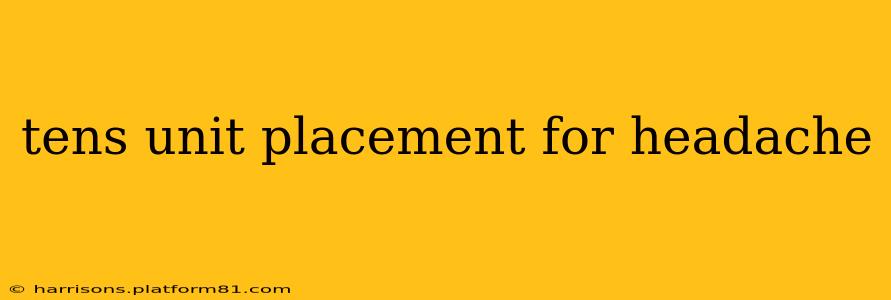Headaches are a common ailment, leaving many seeking effective and drug-free pain relief options. Transcutaneous electrical nerve stimulation (TENS) therapy offers a non-invasive approach, but proper electrode placement is crucial for optimal results. This guide explores effective TENS unit placement strategies for various headache types, offering insights for maximizing relief. We'll also address frequently asked questions to ensure you understand this therapy fully.
Understanding TENS Therapy for Headaches
TENS therapy works by delivering mild electrical pulses through electrodes placed on the skin. These pulses stimulate nerves, blocking pain signals from reaching the brain and potentially triggering the release of endorphins, the body's natural painkillers. The effectiveness of TENS for headaches varies depending on the type and cause of the headache. It's generally most effective for tension headaches and migraines, but may offer some relief for other types as well. It's important to remember that TENS is not a cure, but rather a pain management tool.
Effective TENS Unit Placement Points for Headaches
The optimal placement of TENS electrodes depends on the type and location of your headache. There's no one-size-fits-all solution. Experimentation and finding what works best for you is key. However, some general guidelines exist:
For Tension Headaches:
Tension headaches often manifest as a tight band around the head. Therefore, placing electrodes bilaterally (on both sides) along the temples, forehead, and the back of the neck can be beneficial. You might also try placing one electrode on the painful area and the other on a corresponding point on the opposite side of the head.
For Migraines:
Migraines often present with throbbing pain, typically on one side of the head. Electrode placement should focus on the area of greatest pain. Consider placing one electrode directly over the pain site, and the other on the opposite side of the head, or on a point corresponding to the pain location in the neck or shoulder. Experiment with different placements to determine what provides the most relief.
General Placement Considerations:
- Avoid placing electrodes directly over broken skin, wounds, or open sores.
- Keep electrodes clean and dry.
- Use conductive gel to ensure good contact and prevent skin irritation.
- Start with a low intensity and gradually increase as tolerated.
- Consult your doctor or a physical therapist for personalized guidance.
Frequently Asked Questions About TENS Unit Placement for Headaches
Here are some commonly asked questions regarding TENS unit placement for headaches:
1. Can I use a TENS unit for all types of headaches?
While TENS therapy can be helpful for tension headaches and migraines, its effectiveness varies depending on the type and cause of the headache. It's less likely to provide significant relief for headaches stemming from serious underlying medical conditions. Always consult your physician before using a TENS unit if you have concerns about the nature of your headaches.
2. How long should I leave the TENS unit on for headache relief?
Treatment duration depends on your individual response and the settings you use. You can use it for 20-60 minutes, possibly multiple times a day. Always adhere to the manufacturer’s instructions and discontinue use if you experience discomfort or adverse reactions.
3. What are the potential side effects of using a TENS unit for headaches?
Side effects are generally mild and temporary. They may include skin irritation under the electrodes, a slight burning sensation, or muscle twitching. Serious side effects are rare but possible. Consult your physician if you experience any concerning side effects.
4. Are there any contraindications to using a TENS unit for headaches?
TENS therapy is generally safe but should be avoided in certain situations. Individuals with pacemakers, implanted defibrillators, or those pregnant should consult their doctor before use. People with active bleeding, skin infections, or certain neurological conditions may also need to avoid using TENS units.
5. Does TENS unit placement affect the effectiveness of the treatment?
Absolutely! Correct electrode placement is crucial for directing the electrical impulses to the affected nerves and maximizing the therapeutic benefit. Improper placement can lessen effectiveness or even be uncomfortable.
This comprehensive guide provides valuable information about TENS unit placement for headache relief. Remember that individual responses may vary, and it’s essential to consult with a healthcare professional for personalized advice. While TENS can be a valuable tool in managing headache pain, it should be used as part of a holistic approach to headache management, including identifying and addressing potential underlying causes.
